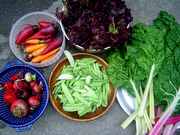

|
| Vegetable Varieties for Gardeners is a citizen science program
|
|
|
|
'Yellow Finn' Potatoes |
| |
| Sub-Category: |
Main Season
|
| |
|
| Sub-Category 2: |
| | Description: |
Mid-season. Oval-flat, pear-shaped tubers with yellow skin and moist, firm, bright-yellow flesh. Excellent storage. Good resistance to scab. Tubers set on long stolons spreading away from medium-sized plant.
|
| Days To Maturity: |
70-90
|
| Seed Sources: |
|
| |
| Rating Summary |
| |
Overall: (4.7 Stars)
Taste: (4.7 Stars)
Yield: (3.7 Stars)
Ease/Reliability: (4.7 Stars) |
| |
| Reviews |
| |
Login to share your Review of Yellow Finn.
Number of Reviews: 3
KEY: O=Overall Rating, T=Taste, Y=Yield, E=Ease
Reviewed on 01/23/2012 by
Soilgeek
- An experienced gardener
|
 Overall Overall
 Taste Taste
 Yield Yield
 Ease Ease
|
Prince of Wales-Outer Ketchikan, Alaska, United States
Frost Free Season: 163 - 183 days
Soil Texture: Loam
Garden Size: Large - More than 1,600 square feet (40' x 40')
Sun Exposure: More than 8 hours per day
|
| I LOVE LOVE LOVE Yellow Finn! Pretty decent yields with a delicious taste. I always have a space in my garden for this potato! |
| |
|
Reviewed on 12/26/2005 by
goodolboy
- An intermediate gardener
|
 Overall Overall
 Taste Taste
 Yield Yield
 Ease Ease
|
Cocke, Tennessee, United States
Frost Free Season: 183 - 203 days
Soil Texture: Clay
Garden Size: Large - More than 1,600 square feet (40' x 40')
Sun Exposure: More than 8 hours per day
|
| In a head to head trial, between Yukon Gold, Yellow Finn and German Butterball, with as close to exact growing conditions as we could provide, we found the Yellow Finn to be nearly identical in yield to the Yukon Gold, but both were quite low per foot of row planted at the same seed spacing compared to the German Butterball (see GBB review), which in turn was lower in yield than our other staple potatoes.
The seed germinated decently, plants were easy to tend, the average tuber size of the 100 largest YF tubers we grew that year was 3.00 oz. compared to 3.04 oz for the GBB. The Yukons were considerably heavier on average, but fewer in number than either the GBB or the YF, the average size difference being so marked that I didn't even weigh the Yukons, as the primary purpose that I had for growing the Finns at the time was to find something that was significantly higher yielding and potentially more marketable than the Yukons, and this was not the case, and although the Finn was actually slightly higher, the 2 were very close in overall yield.
I cannot speak to storage, as we found the taste to be a little less to our liking than that of the Yukon Gold, so they were all given away after a few taste tests yielded the same results. The overall physical appearance of the Finn tubers was quite good.
Since in our experience with 10+ years of growing the Yukons, there was nothing really compellingly better about the Yellow Finn, it suffered only by comparison. Strictly on it's own merits, it's a good potato.
I'm still looking for a much better yielding yellow flesh potato that has the other attributes of the Yukon, most notably being ease of growing, long storage capability, an equal or better taste and versatility of use. |
| |
|
Reviewed on 12/01/2005 by
Joachim
- An experienced gardener
|
 Overall Overall
 Taste Taste
 Yield Yield
 Ease Ease
|
Fairfield, Connecticut, United States
Frost Free Season: 163 - 183 days
Soil Texture: Loam
Garden Size: Large - More than 1,600 square feet (40' x 40')
Sun Exposure: More than 8 hours per day
|
| Yellow Finn is one of the best tasting potatoes in the world and fairly easy to grow, although it does best in the North Pacific region. More flavor and better texture when compared to Yukon Gold, also a good storage variety. |
| |
|
|
|
|
Vegetable Varieties for Gardeners is a citizen science program, © 2004-2024, All Rights Reserved
Cornell Garden Based Learning, Cornell University College of Agriculture & Life Sciences, Horticulture Section
|






 VVfG home
VVfG home
 Overall
Overall Yield
Yield Yield
Yield